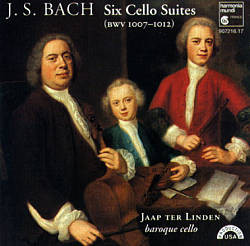
Jaap Ter Linden Bach Cello Suites. CD harmonia mundi HMU 907216.17
Released 1997.
Recorded at Forde Abbey, Chard, Somerset, UK October 21-28th 1996.
Cellos used: 4string cello by Carlo Bergonzi c.1725-30 and five string Amati c. 1600.
No other information regards set up or bow used.
The Cellist.
The CD booklet describes Jaap Ter Linden as one of Europe’s most prominent baroque musicians. A comprehensive c.v. is provided.
Evidence of this might be that he is the only Baroque player apart from Wispelwey to record the Suites twice in Baroque style. What about Anner Bylsma you may say? To my mind his second recording on the Servais Stradivarius cello is a mainstream interpretation and represents his ability to span the authentic Baroque to modern mainstream repertoire.
The Recording.
Almost certainly, Linden will have had a set up including gut strings tuned to lower frequency than concert A, used Baroque bow and no end pin. This is evidenced by the few video recordings available. I notice on those videos a sparing use of vibrato particularly at the start of bowing.
The sound quality of the recording is excellent with placement well judged, in my opinion. There is a spacious soundstage without prominent echo. The harmonics of the gut string are well captured without harshness and with a fulsome lower register.
The Music.
I found this recording for the most part a very enjoyable listen. There is a light airy touch to his playing with few notes appearing forced. Ter Linden employs a laid back smooth sound with plenty of legato passages complementing the articulated passages. In fact he noticeably “mixes it up” quite frequently. By this I do not mean he gets confused! The performer introduces a lot of variety in this rendition. Not just in repeats where he often plays with a laid back approach the first time, then urgency the second time. Between phrases he also varies the mix of slurred and separately bowed notes. I thought this added to the interest possibly at the expense of flow.
A Reservation.
The only thing that slightly jarred with me was the lunging sound of split chords particularly in the Sarabandes. In fact, In my listening notes for the fourth Suite I conjured up an image of rather intoxicated dancers moving around in a rather ungainly manner! I should add this is the exception and for the most part Ter Linden applies a fine sense of rhyhm with a sense of ebb and flow, with good momentum throughout the whole recording.
Highlights were nimble Gigues, grand Preludes, well articulated Courantes, and rustic Gavottes.
The sixth Suite impressed with the Prelude but slightly disappointed with the final Gigue. I’m not sure if this was a technique issue or related to the instrument used.
Amaryllis Flemming.
There is a cryptic message of thanks to Amaryllis Flemming. There is no reason given but I suspect this related to the five string Amati instrument used in the sixth Suite. Flemming died after this recording was made and owned a five string Amati on which she performed and possibly recorded the Suites. The recordings for the BBC do not appear to have surfaced if indeed they still exist.
It seems reasonable although not evidenced to suggest this may be the instrument used on this recording.
Conclusion.
I reviewed the second recording of the Suites from 2006 by Ter Linden sometime ago. My main reservations were a rather coarse sound and general sense of lack of direction. This first recording certainly has a smoother more refined sound to the cello and the music feels to have more momentum. Both I feel tend to have a sense of being made up of many parts rather than a continuous joined up structure. This first I would recommend to anyone wanting an authentic performance without dramatic variation in tempo and with a pleasing sound for relaxed listening.
Charles.